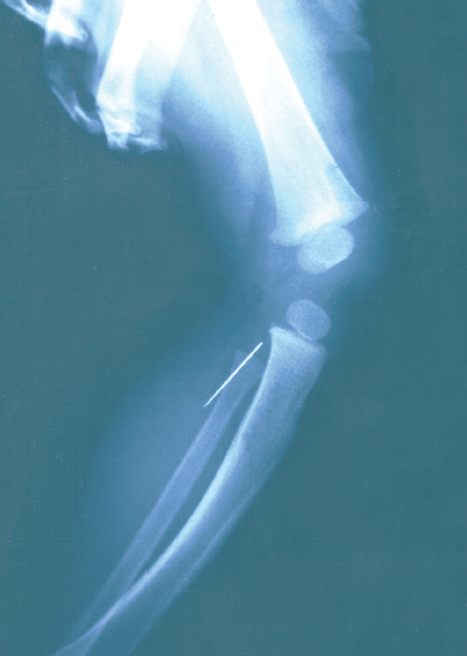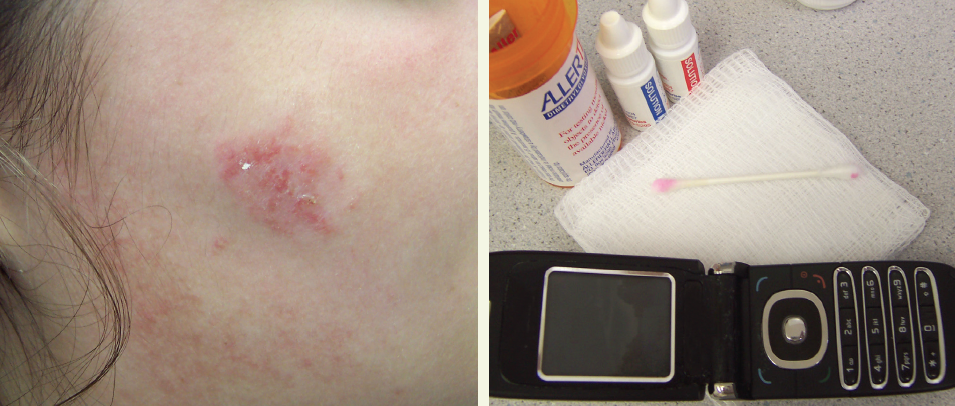A Collection of Allergic Reactions
Systemic Allergic Reaction to Embedded Sewing Needle
Anatoly Belilovsky, MD, and Michael LaCorte, MD
A thriving boy was brought to the office 3 weeks after his first birthday. His mother reported that there was “something wrong with his knee.”
Physical examination. The knee appeared perfectly normal. On palpation, however, a 4 cm linear induration was evident over the knee fat pad, just medial and distal to the patella. It appeared soft, crepitant, and associated with the skin. No tenderness was noted on palpation; the infant did not object to palpation of this density any more than to auscultation, otoscopy, or anthropometric measurements. No erythema, ecchymosis, or signs of trauma were evident near the lesion. The only possibly relevant history was that the child had spent his birthday at his grandmother’s home in the Ukraine a month earlier. He was constantly with his mother during that time, and no trauma was ever reported.
Radiographs were initially considered, but it was felt that the soft lesion was unlikely to be radiopaque. The infant was referred to a pediatric surgeon who agreed with the findings but was unable to determine the cause of the lesion.

Follow-up presentation. Four days after the initial visit, the child returned to the office with urticaria. This was thought to be a reaction to the grape juice that was newly introduced to the child's diet. The grape juice was discontinued and the child was treated with an oral antihistamine. By day 7, however, the urticaria was severe enough to require epinephrine and oral corticosteroids.
Laboratory testing. Radiographs were ordered and, to everyone’s surprise, the films revealed a sewing needle in the subcutaneous tissue. The child’s mother did not sew at home; however, sewing needles had been present at the grandmother's home where the infant had crawled about on his hands and knees.
A repeated examination of the child’s knee revealed no sign of an entry wound; there was no ecchymosis, no tenderness, and no local reaction, and the lesion still appeared soft and yielding on palpation, with some crepitus.
Stainless steel always contains chromium and usually nickel as well. Either metal may produce systemic allergic phenomena with only localized exposure.
Treatment. Based on this information, the needle was removed 13 days after the initial presentation, while the infant was still being treated for urticaria. The tiny incision healed uneventfully and there was no evidence of rash during a 3-month follow-up.
Discussion. This child had generalized urticaria that developed roughly a month after a needle became embedded. There was no localized reaction. Every clinician who examined this child found the lesion to be soft and flexible. For this reason, radiographs were delayed by a week.
Although the most common presentation of metal allergy is chronic, lichenified, contact dermatitis from nickel-containing jewelry and accessories, systemic atopic and urticarial reactions to localized contact with alloys and salts have been described. Metallothionein induction and subsequent sensitization are thought to be a possible disease mechanism.
The views expressed herein are those of the author and do not reflect the official policy or position of the Department of the Navy, Department of Defense, or the US government.
References:
1. Jin GB, Nakayama H, Shmyhlo M, et al. High positive frequency of antibodies to metallothionein and heat shock protein 70 in sera of patients with metal allergy. Clin Exp Immunol. 2003;131(2):275-279.
2. Takazawa K, Ishikawa N, Miyagawa H, et al. Metal allergy to stainless steel wire after coronary artery bypass grafting. J Artif Organs. 2003;
6(1):71-72.
3. Tamai K, Mitsumori M, Fujishiro S, et al. A case of allergic reaction to surgical metal clips inserted for postoperative boost irradiation in a patient undergoing breast-conserving therapy. Breast Cancer. 2001;
8(1):90-92.
Allergic Reaction to Bahia Grass
Sunita Puri, MD
After mowing the lawn for the first time, a 12-year-old boy had severe pruritus all over his body, watery and puffy eyes, and a husky voice. His mother rushed him to the closest acute care facility, where he received an oral corticosteroid and antihistamine. He reported no shortness of breath or abdominal pain. During the history taking, it was learned that the child had undergone allergy testing a few years earlier. The results had revealed a positive reaction to grass, especially Bahia.

Bahia grass (Paspalum notatum) is an allergenically important grass in the Gulf Coast states and a significant aeroallergen. It can induce asthma, allergic rhinitis, and allergic conjunctivitis.1 An association between Bahia grass and asthma in children has been documented.2 Treatment consists of antihistamines, decongestants, or corticosteroid nasal sprays for immediate allergy symptoms and immunotherapy for long-term relief.
Outcome of the case. This boy’s symptoms quickly subsided, and he was discharged home within 2 hours after his arrival. He was told to avoid similar exposure to Bahia grass pollen.
References:
1. Hensel AE Jr, Griffith RC. Clinical experiences with Paspalum notatum (Bahia grass): a new grass antigen. South Med J. 1972;65(6):690-693.
2. Bass DJ, Delpech V, Beard J, et al. Late summer and fall (March-May) pollen allergy and respiratory disease in Northern New South Wales, Australia. Ann Allergy Asthma Immunol. 2000;85(5):374-381.
Allergic Angioedema
Sunita Puri, MD
This 41-year-old woman rushed to the emergency department with a swollen, blistered tongue and difficultly in swallowing and speaking. Twenty minutes earlier she had eaten fish for the first time in her life. Her vital signs were normal.

This is an example of allergic angioedema, a form of localized submucosal or dermal swelling of the lips, tongue, eyelids, and even the pharynx. Antigenic stimuli include eggs, shellfish, peanuts, walnuts, and cow’s milk; various drugs; insect bites; and infection. Serious allergic reactions, which occur within minutes to 2 hours, include acute angioedema of the upper airway, severe bronchial asthma, and anaphylaxis. These systemic responses result from the so-called immediate hypersensitivity reaction, in which IgE and histamine play essential roles. The onset is explosive, but resolution is rapid following administration of antihistaminic agents.
This patient responded to epinephrine and diphenhydramine and was advised never again to eat fish. She was followed closely thereafter and had no further problems.
Nickel Dermatitis
Jonathan Stuart Crane, DO, Erin Griffin, BS, and Christine Cook, CCRC
An 18-year-old girl presented with a red, scaly rash on her cheeks that had been scabbing over, peeling, and draining. She had had similar reactions to earrings and inexpensive jewelry. The appearance of the rash coincided with the use of a new cell phone..

Laboratory testing. An allergy to nickel on the cell phone was suspected. A dimethylglyoxime test (Allertest Ni) was performed in which 2 solutions were applied to a cotton swab that was then rubbed over the metal area of the phone. The swab turned pink, confirming the presence of nickel. Results of patch tests applied to the patient’s back showed a strong positive reaction to nickel.
Discussion. Nickel dermatitis is the most common form of contact dermatitis and has been linked to cell phone use.1 Nickel dermatitis associated with cell phone use should be included in the differential diagnosis of unusual facial rashes. This is true even if the cell phone was not recently purchased, because nickel allergies can take time to develop.

Allergic reactions to nickel are easily prevented. For example, patients can use a barrier between the skin and the allergen, wear stainless steel earrings, or paint clear fingernail polish on keys. If it is an occupational exposure (eg, nickel in an industrial compound), rubber gloves may be ineffective; in this case, heavy-duty vinyl gloves may be used.
This patient was treated with triamcinolone ointment, and the rash resolved within a week. She purchased a new cell phone, and no further rashes occurred.
Reference:
1. Luo J, Bercovitch L. Cellphone contact dermatitis with nickel allergy [published correction appears in CMAJ 2008;178:440]. CMAJ. 2008;178:23-24.
Neomycin Contact Dermatitis
Michelle Blanco, MD, and Daniel Lee, MD
Two weeks earlier, a 25-year-old woman had sustained a thermal burn to the right forearm. About 1 week after the injury, the eschar sloughed off and she applied an over-the-counter antibiotic ointment (neomycin) to the wound site. Several hours later, pruritus developed, followed by a rash at the wound site. The patient denied any other symptoms; she had no significant medical history.
Physical examination revealed numerous small vesicular lesions with crusting on an erythematous base, involving the wound site and adjacent skin. The diagnosis of allergic contact dermatitis to neomycin was made.

Discussion. Allergic contact dermatitis is a delayed hypersensitivity reaction resulting from repeated exposure to an allergen. The shape and location of the rash provide important clues to the cause of the allergen. The intensity of the reaction depends on the degree of sensitivity and concentration of the antigen.1 Neomycin contact dermatitis is related to the extent of use and has been noted to affect preferentially areas of previously damaged skin.2 It typically manifests as pruritus with vesicles and bullae, with distinct borders on areas of exposed skin. The diagnosis can be made from the history and physical examination and, if necessary, confirmed by patch testing.
Initial treatment involves removal and future avoidance of products that contain the allergen. Patients who have an allergic reaction to topical neomycin should be presumed to have an allergy to related aminoglycosides. Localized areas of allergic contact dermatitis may be treated with moderate- to high-potency corticosteroids to reduce symptoms of itching and speed resolution of the rash.
Outcome of the case. This patient was treated with a mid-potency corticosteroid ointment, and her rash resolved within 2 days.
References:
1. Habif TP. Contact dermatitis and patch testing. In: Habif TP, ed. Clinical Dermatology. 5th ed. Philadelphia, PA: Mosby Elsevier; 2010:133-146.
2. Kirton V, Munro-Ashman D. Contact dermatitis from neomycin and framycetin. Lancet. 1965;1:138-139.


